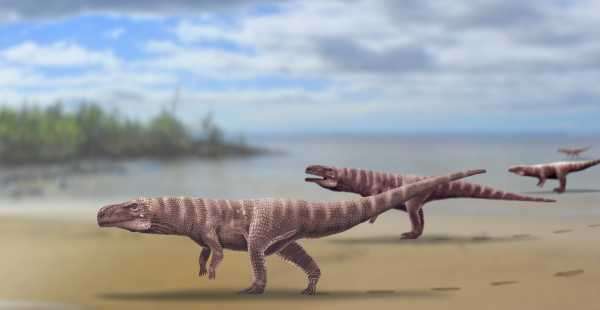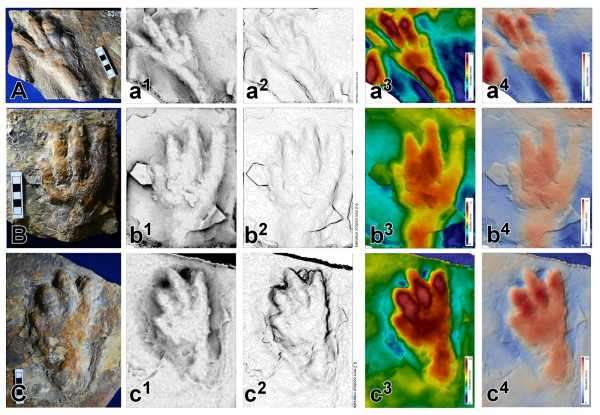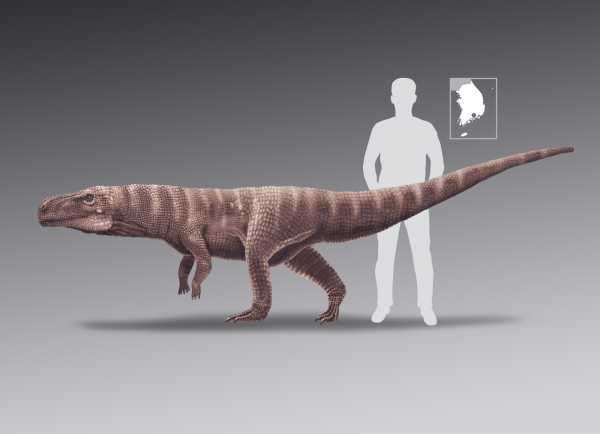
The two-legged crocodile relative, which left the fossil footprints in what is now South Korea, may have looked like this.
A hefty, 10-foot-long (3 meters) crocodile relative had an odd way of getting around 120 million years ago in what is now South Korea. The huge beast walked on its two hind legs like a T. rex, researchers said after analyzing footprints left behind by the reptile.
There are no known fossilized bones of this strange crocodile, but dozens of its up to 120 million year-old footprints, including one with skin impressions, are preserved in stone.
“For the first time, we have proof that some of the giant crocodiles of the Cretaceous were bipedal and really designed like the carnivorous dinosaurs,” study co-researcher Martin Lockley, professor emeritus of geology at the University of Colorado Denver, told Live Science.
Researchers found the fossilized footprints ahead of a construction project. Researchers named it the Sacheon Jahye-ri tracksite, as it’s west of Sacheon City in South Gyeongsang Province.
The track marks are big, up to 9.5 inches (24 centimeters) long, the researchers said. The crocodile also likely “had legs about the same height as human adult legs,” study senior researcher Anthony Romilio, a paleontologist at the University of Queensland in Australia, said in a statement.

Photos and 3D images of the tracks found in South Korea.
After Korean researchers transferred the trackways to a lab, they invited Lockley to look at the impressions in November 2019. Initially, the team thought that these prints might belong to a giant pterosaur, but the instant Lockley saw them, he said he knew they were from a crocodile relative.
Previously, Lockley had studied crocodile prints from the Jurassic period (199 million to 145 million years ago). The crocodile that left those prints was much smaller — its tracks were about 1 inch, or 2.5 centimeters long — and it walked on all fours. Even so, those prints were remarkably similar to the newly discovered ones, he said.
This realization triggered another memory; Lockley and his colleagues had published a study in 2012 in the journal Ichnos on what they thought were giant pterosaur tracks from the Cretaceous period of Korea. At the time, however, they knew something was weird about the tracks, so they called them “enigmatic.” Looking back, Lockley realized that just like the newfound tracks, the enigmatic prints are most likely from a two-legged crocodile.
Working together, the team found myriad clues that the newfound trackway belonged to a crocodile and not a pterosaur. For example, pterosaurs likely used their wings while walking, meaning they walked on all fours. But no handprints (or wing prints, for that matter) were found. In addition, the skin impression found on a heel print resembled that of a crocodile, Lockley said. Moreover, the prints had robust digits and impressions of pads and joints that looked just like those from a crocodile, he said.

Photos and 3D images of the tracks found in South Korea.
That said, it’s understandable that the researchers initially thought these trackways belonged to giant pterosaurs. “Typical crocodiles walk in a squat stance and create trackways that are wide,” study lead researcher Kyung Soo Kim, a paleoecologist at the Chinju National University of Education in South Korea, said in the statement. “Oddly, our trackways are very narrow looking — more like a crocodile balancing on a tight-rope.”
“When [the footprints were] combined with the lack of any tail-drag marks, it became clear that these creatures were moving bipedally,” Kim said.
The team named the newfound fossil prints Batrachopus grandis. (Trace fossils, such as fossilized trackways and burrows, are given scientific names, just as animals are.)
During the lower Cretaceous, the track site was a lake surrounded by muddy ground, “which made for making good tracks,” Lockley told Live Science. It’s difficult to say how these prints were preserved, but perhaps the creature left the prints in wet mud just before the lake retreated, allowing the prints to dry and harden. When the water level rose again, mud and fine silt could have covered and preserved the tracks, Lockley said.
Or, maybe the mud was soft and soupy, like warm ice cream, but the ground under the “ice cream” was hard, he said. The crocodile could have squished through the muck and left an impression on the hard ground underneath, which would have been instantly buried and preserved by the “ice cream” when the animal lifted up its foot, Lockley said.
The study was published online yesterday (June 11) in the journal Scientific Reports.
Sourse: www.livescience.com
